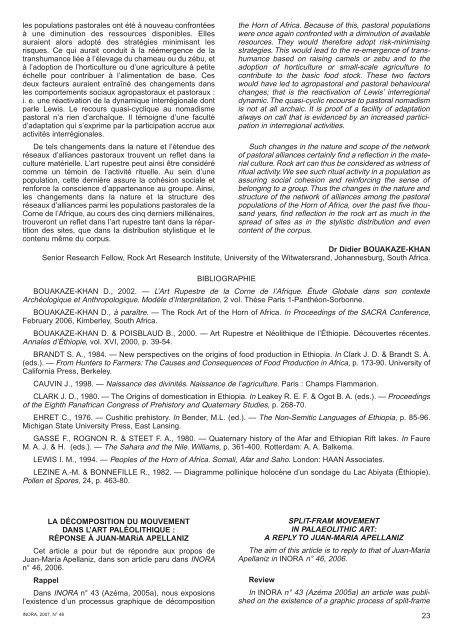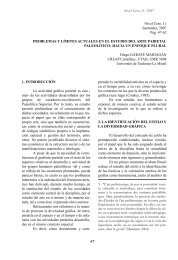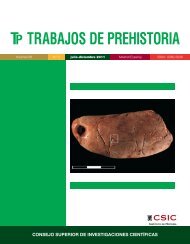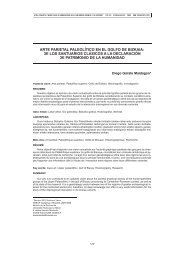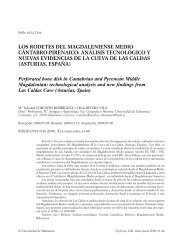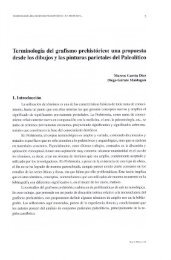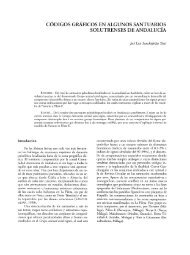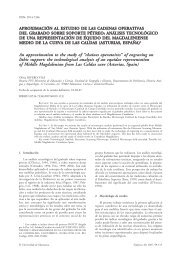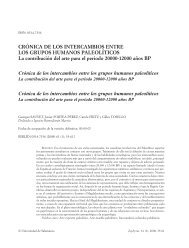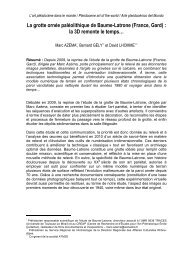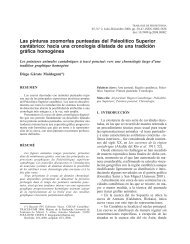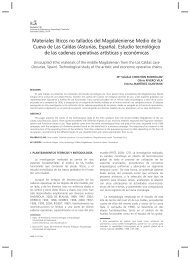La décomposition du mouvement dans l'art paléolithique - Icomos
La décomposition du mouvement dans l'art paléolithique - Icomos
La décomposition du mouvement dans l'art paléolithique - Icomos
Create successful ePaper yourself
Turn your PDF publications into a flip-book with our unique Google optimized e-Paper software.
les populations pastorales ont été à nouveau confrontées<br />
à une diminution des ressources disponibles. Elles<br />
auraient alors adopté des stratégies minimisant les<br />
risques. Ce qui aurait con<strong>du</strong>it à la réémergence de la<br />
transhumance liée à l’élevage <strong>du</strong> chameau ou <strong>du</strong> zébu, et<br />
à l’adoption de l’horticulture ou d’une agriculture à petite<br />
échelle pour contribuer à l’alimentation de base. Ces<br />
deux facteurs auraient entraîné des changements <strong>dans</strong><br />
les comportements sociaux agropastoraux et pastoraux :<br />
i. e. une réactivation de la dynamique interrégionale dont<br />
parle Lewis. Le recours quasi-cyclique au nomadisme<br />
pastoral n’a rien d’archaïque. Il témoigne d’une faculté<br />
d’adaptation qui s’exprime par la participation accrue aux<br />
activités interrégionales.<br />
the Horn of Africa. Because of this, pastoral populations<br />
were once again confronted with a diminution of available<br />
resources. They would therefore adopt risk-minimising<br />
strategies. This would lead to the re-emergence of transhumance<br />
based on raising camels or zebu and to the<br />
adoption of horticulture or small-scale agriculture to<br />
contribute to the basic food stock. These two factors<br />
would have led to agropastoral and pastoral behavioural<br />
changes; that is the reactivation of Lewis’ interregional<br />
dynamic. The quasi-cyclic recourse to pastoral nomadism<br />
is not at all archaic. It is proof of a facility of adaptation<br />
always on call that is evidenced by an increased participation<br />
in interregional activities.<br />
De tels changements <strong>dans</strong> la nature et l’éten<strong>du</strong>e des<br />
réseaux d’alliances pastoraux trouvent un reflet <strong>dans</strong> la<br />
culture matérielle. L’art rupestre peut ainsi être considéré<br />
comme un témoin de l’activité rituelle. Au sein d’une<br />
population, cette dernière assure la cohésion sociale et<br />
renforce la conscience d’appartenance au groupe. Ainsi,<br />
les changements <strong>dans</strong> la nature et la structure des<br />
réseaux d’alliances parmi les populations pastorales de la<br />
Corne de l’Afrique, au cours des cinq derniers millénaires,<br />
trouveront un reflet <strong>dans</strong> l’art rupestre tant <strong>dans</strong> la répartition<br />
des sites, que <strong>dans</strong> la distribution stylistique et le<br />
contenu même <strong>du</strong> corpus.<br />
Such changes in the nature and scope of the network<br />
of pastoral alliances certainly find a reflection in the material<br />
culture. Rock art can thus be considered as witness of<br />
ritual activity. We see such ritual activity in a population as<br />
assuring social cohesion and reinforcing the sense of<br />
belonging to a group. Thus the changes in the nature and<br />
structure of the network of alliances among the pastoral<br />
populations of the Horn of Africa, over the past five thousand<br />
years, find reflection in the rock art as much in the<br />
spread of sites as in the stylistic distribution and even<br />
content of the corpus.<br />
Dr Didier BOUAKAZE-KHAN<br />
Senior Research Fellow, Rock Art Research Institute, University of the Witwatersrand, Johannesburg, South Africa.<br />
BIBLIOGRAPHIE<br />
BOUAKAZE-KHAN D., 2002. — L’Art Rupestre de la Corne de l’Afrique. Étude Globale <strong>dans</strong> son contexte<br />
Archéologique et Anthropologique. Modèle d’Interprétation. 2 vol. Thèse Paris 1-Panthéon-Sorbonne.<br />
BOUAKAZE-KHAN D., à paraître. — The Rock Art of the Horn of Africa. In Proceedings of the SACRA Conference,<br />
February 2006, Kimberley, South Africa.<br />
BOUAKAZE-KHAN D. & POISBLAUD B., 2000. — Art Rupestre et Néolithique de l’Éthiopie. Découvertes récentes.<br />
Annales d’Éthiopie, vol. XVI, 2000, p. 39-54.<br />
BRANDT S. A., 1984. — New perspectives on the origins of food pro<strong>du</strong>ction in Ethiopia. In Clark J. D. & Brandt S. A.<br />
(eds.). — From Hunters to Farmers: The Causes and Consequences of Food Pro<strong>du</strong>ction in Africa, p. 173-90. University of<br />
California Press, Berkeley.<br />
CAUVIN J., 1998. — Naissance des divinités. Naissance de l’agriculture. Paris : Champs Flammarion.<br />
CLARK J. D., 1980. — The Origins of domestication in Ethiopia. In Leakey R. E. F. & Ogot B. A. (eds.). — Proceedings<br />
of the Eighth Panafrican Congress of Prehistory and Quaternary Studies, p. 268-70.<br />
EHRET C., 1976. — Cushitic prehistory. In Bender, M.L. (ed.). — The Non-Semitic <strong>La</strong>nguages of Ethiopia, p. 85-96.<br />
Michigan State University Press, East <strong>La</strong>nsing.<br />
GASSE F., ROGNON R. & STEET F. A., 1980. — Quaternary history of the Afar and Ethiopian Rift lakes. In Faure<br />
M. A. J. & H. (eds.). — The Sahara and the Nile. Williams, p. 361-400. Rotterdam: A. A. Balkema.<br />
LEWIS I. M., 1994. — Peoples of the Horn of Africa. Somali, Afar and Saho. London: HAAN Associates.<br />
LEZINE A.-M. & BONNEFILLE R., 1982. — Diagramme pollinique holocène d’un sondage <strong>du</strong> <strong>La</strong>c Abiyata (Éthiopie).<br />
Pollen et Spores, 24, p. 463-80.<br />
LA DÉCOMPOSITION DU MOUVEMENT<br />
DANS L’ART PALÉOLITHIQUE :<br />
RÉPONSE À JUAN-MARíA APELLANIZ<br />
Cet article a pour but de répondre aux propos de<br />
Juan-María Apellaniz, <strong>dans</strong> son article paru <strong>dans</strong> INORA<br />
n° 46, 2006.<br />
Rappel<br />
Dans INORA n° 43 (Azéma, 2005a), nous exposions<br />
l’existence d’un processus graphique de <strong>décomposition</strong><br />
SPLIT-FRAM MOVEMENT<br />
IN PALAEOLITHIC ART:<br />
A REPLY TO JUAN-MARIA APELLANIZ<br />
The aim of this article is to reply to that of Juan-Maria<br />
Apellaniz in INORA n° 46, 2006.<br />
Review<br />
In INORA n° 43 (Azéma 2005a) an article was published<br />
on the existence of a graphic process of split-frame<br />
INORA, 2007, N° 48<br />
23
<strong>du</strong> <strong>mouvement</strong> <strong>dans</strong> l’art <strong>paléolithique</strong>. C’est un des<br />
résultats les plus «spectaculaires» de notre travail de<br />
thèse consacré à l’étude de la représentation <strong>du</strong> <strong>mouvement</strong><br />
<strong>dans</strong> <strong>l'art</strong> pariétal français par le biais de l’éthologie<br />
(Azéma, 2003, 2005b, 2006). L’intégralité de cette recherche<br />
est actuellement en cours de publication.<br />
L’analyse précise de 4 634 représentations zoomorphes,<br />
dont 871 indéterminées, a notamment abouti à la<br />
mise en évidence de plusieurs dizaines de cas (52 figures)<br />
de <strong>décomposition</strong> <strong>du</strong> <strong>mouvement</strong> par superposition<br />
d’images successives. Dans le cadre de cette recherche,<br />
il a paru opportun d’étayer cette hypothèse par des comparaisons<br />
avec des images <strong>paléolithique</strong>s présentant les<br />
mêmes caractéristiques dynamiques. Enfin, l’utilisation<br />
de techniques audiovisuelles nous a permis de « recomposer<br />
» les <strong>mouvement</strong>s décomposés en images successives<br />
par les artistes préhistoriques. Cette expérience est<br />
visible sous forme d’un film vidéo sur le site internet :<br />
http://www.passesimple.net/rockart_azema.htm<br />
Bien enten<strong>du</strong>, nous ne bénéficions pas <strong>du</strong> témoignage<br />
des auteurs, mais il est pour nous probable que la multiplication<br />
des contours observée sur ces 52 figures tra<strong>du</strong>it<br />
la quatrième dimension, à savoir le temps, et pas obligatoirement<br />
l’expression de maladresses ou de repentirs<br />
comme tente de le démontrer Apellaniz (ibid.).<br />
Analyse des traits et des <strong>mouvement</strong>s<br />
Tout d’abord, quelques précisions sur notre méthodologie<br />
: chaque figure recensée <strong>dans</strong> le corpus a été étudiée<br />
minutieusement, trait par trait, en tenant compte de<br />
la réalité anatomique des modèles vivants, <strong>du</strong> comportement<br />
des espèces les plus proches, mais également des<br />
contraintes liées au support et aux techniques de représentation<br />
employées, <strong>du</strong> contexte chronoculturel pouvant<br />
engendrer des déformations volontaires (styles), involontaires<br />
(maladresses), des corrections ou des repentirs<br />
suivant le talent ou les intentions des artistes.<br />
Le fruit de cette analyse rigoureuse nous a con<strong>du</strong>it à<br />
définir le processus de <strong>décomposition</strong> <strong>du</strong> <strong>mouvement</strong> par<br />
superposition d’images successives : «Les positions prises<br />
successivement <strong>dans</strong> le temps par l’animal sont<br />
superposées. <strong>La</strong> <strong>décomposition</strong> <strong>du</strong> <strong>mouvement</strong> concerne<br />
l’ensemble <strong>du</strong> corps ou une seule de ses parties (tête,<br />
membres, queue). <strong>La</strong> somme de ces superpositions doit<br />
former un tout cohérent, tant au niveau technique que stylistique,<br />
preuve que l’œuvre a été exécutée en une seule<br />
fois et par une seule main»<br />
(Azéma, 2005a, p. 15).<br />
L’un des exemples les<br />
plus probants est ce petit<br />
cheval gravé sur une<br />
plaquette de Limeuil <strong>du</strong><br />
Magdalénien supérieur<br />
(fig. 1). Pour J.-M. Apellaniz,<br />
l’analyse de cette seule figure<br />
suffit à la proposer «<br />
comme un modèle applicable<br />
à toutes les autres »<br />
(Ibid., p. 24). <strong>La</strong> multiplication<br />
des contours correspondrait<br />
à des corrections,<br />
«sauf peut-être à la frise<br />
des lions de <strong>La</strong> Vache, car<br />
les multiples répétitions<br />
décalées de leurs membres<br />
et de leurs traits sont alors<br />
plus fréquentes et, <strong>dans</strong> ce<br />
dernier cas, davantage<br />
Fig. 1. Cheval de Limeuil, plaquette n° 60.<br />
Relevé G. Tosello (2003, fig. 89). Dimension de la figure : environ 5 cm.<br />
Fig. 1. Limeuil Horse. Plaque n° 60. Copy G. Tosello (2003, Fig. 89).<br />
Dimension of the figure: around 5 cm.<br />
movement in Palaeolithic art. It was one of the most<br />
“spectacular” results of a thesis devoted to studying the<br />
representation of movement in French parietal art from an<br />
animal behavioural viewpoint (Azéma 2003, 2005b,<br />
2006). The whole of this research is at present in the process<br />
of being published.<br />
A detailed analysis of 4,634 zoomorphic representations,<br />
of which 871 were indeterminate, pro<strong>du</strong>ced evidence<br />
of several dozen cases (52 figures) of split-frame movement<br />
by the superimposing of successive images. As part<br />
of this research, it seemed useful to buttress the hypothesis<br />
by comparisons with Palaeolithic images presenting<br />
the same dynamic characteristics. Finally, the use of<br />
audiovisual techniques enabled the “reconstitution” of the<br />
movements broken down into successive images<br />
by the prehistoric artists. This experiment is visible<br />
as a video film on the internet site:<br />
http://www.passesimple.net/rockart_azema.htm.<br />
Obviously we have no statements from the authors of<br />
these images, but it seems highly likely that the multiple<br />
contours seen in these 52 figures translate the fourth<br />
dimension –i.e. time– and do not necessarily express<br />
errors or second thoughts as J.-M. Apellaniz attempts to<br />
demonstrate (ibid.).<br />
Analysis of lines and movements<br />
Firstly, let us recall some methodological details for the<br />
reader: each figure noted in the corpus was minutely studied,<br />
line by line, taking into account not only the anatomical<br />
reality of the living models and the behaviour of the<br />
nearest animal species, but also the constraints linked to<br />
the rock “canvas” and the chrono-cultural context likely to<br />
pro<strong>du</strong>ce voluntary deformations (styles) or involuntary<br />
ones (mistakes), corrections or second thoughts related<br />
to the talent or intentions of the artist.<br />
The results of this rigorous analysis led to a definition<br />
of split-frame movement by the superimposition of successive<br />
images: “the successive positions taken by the<br />
animal over time are superimposed. The breakdown of<br />
movement concerns the whole of the body or one of its<br />
parts (head, legs, tail). The sum of these superimpositions<br />
should form a coherent whole, at both the technical and<br />
stylistic levels, a proof that the work was done at one go<br />
by a single person” (Azéma 2005a: 15).<br />
One of the most convincing<br />
examples is this little<br />
horse engraved on a plaque<br />
from Limeuil dated to the<br />
Upper Magdalenian (Fig. 1).<br />
For J.-M. Apellaniz, the analysis<br />
of this single figure suffices<br />
to propose it “as a<br />
model applicable to all the<br />
others” (ibid.: 24). The multiple<br />
contours would correspond<br />
to corrections<br />
“except perhaps for the Lion<br />
Frieze at <strong>La</strong> Vache, as the<br />
repeated multiple representations<br />
of legs and their lines<br />
are even more frequent and,<br />
in this latter case more likely<br />
to show the presumed<br />
movement.” Apellaniz is mis-<br />
24<br />
INORA, 2007, N° 48
susceptibles d’exprimer le <strong>mouvement</strong> présumé.»<br />
Apellaniz se trompe, car il n’a pas bien saisi la définition <strong>du</strong><br />
second procédé exposé <strong>dans</strong> mon article. En effet, la frise<br />
de <strong>La</strong> Vache (Ibid., tabl. 2) reflète une <strong>décomposition</strong> <strong>du</strong><br />
<strong>mouvement</strong> par juxtaposition (et non superposition) d’images<br />
: les membres ne sont pas répétés, mais les trois<br />
images de félin exécutées sans repentir ou correction<br />
correspondent à «trois phases consécutives de la course<br />
d’un lion» (Ibid.: 20).<br />
Pour en revenir à la plaquette de Limeuil, plutôt que de<br />
commenter point par point l’analyse de J.-M. Apellaniz,<br />
nous répondrons à ses principales critiques.<br />
Dans l’animal représenté, Apellaniz (p. 24) identifie<br />
une biche et non un cheval, en raison de la brièveté de sa<br />
queue. Pourtant, les contours et proportions de l’animal,<br />
<strong>du</strong> corps, des membres, de l’encolure et de la tête sont<br />
suffisants pour reconnaître un cheval, comme le propose<br />
Gilles Tosello (2003, p. 140-141), auteur <strong>du</strong> relevé<br />
(qu’Apellaniz nous attribue par erreur), pariétaliste reconnu<br />
et également illustrateur naturaliste habitué à observer<br />
les animaux vivants et donc à les reconnaître, en particulier<br />
les équidés. Rappelons que l’absence de queue ou sa<br />
ré<strong>du</strong>ction s’observe régulièrement <strong>dans</strong> l’art <strong>paléolithique</strong><br />
sans que cela remette en cause l’identification d’un animal<br />
d’après les caractéristiques morphologiques de l’ensemble<br />
<strong>du</strong> corps : sur certains bisons <strong>du</strong> Salon Noir de<br />
Niaux, la queue est à peine ébauchée, et sur d’autres<br />
complètement absente, sans que cela contredise leur<br />
identification. À Limeuil, cette ré<strong>du</strong>ction de la queue peut<br />
facilement s’expliquer par la petitesse de la figure, à<br />
peine 5 cm de long (précision essentielle omise par<br />
Apellaniz <strong>dans</strong> sa longue analyse), ou le fait qu’il s’agit<br />
d’un poulain (détail déjà noté par l’auteur de la fouille,<br />
J. Bouysonnie). L’artiste a voulu insister sur le <strong>mouvement</strong><br />
des membres, se contentant d’ébaucher par de<br />
petits coups de silex (ne mesurant que quelques millimètres),<br />
un appendice caudal qui, il faut l’ajouter, se trouve<br />
à différents moments <strong>du</strong> galop en partie dissimulé entre<br />
les membres postérieurs, donc peu visible pour l’observateur,<br />
comme <strong>dans</strong> ce cas précis.<br />
Les dimensions ré<strong>du</strong>ites de cette figure peuvent expliquer<br />
certaines «interruptions de ses contours» (p. 25)<br />
observées par Appelaniz au niveau de la tête ou de la<br />
croupe. Cependant, la multiplication des contours des<br />
membres, en raison même de leur organisation, témoigne<br />
plutôt de la dextérité d’un artiste maniant avec sûreté son<br />
silex pour créer un véritable flou dynamique, reflet des<br />
limites de notre perception visuelle (persistance rétinienne)<br />
confrontée à l’observation des <strong>mouvement</strong>s rapides<br />
(allures) <strong>dans</strong> la nature ; bien des millénaires plus tard,<br />
les animateurs de dessins animés et les dessinateurs de<br />
bandes dessinées utiliseront le même procédé.<br />
Selon nous, les deux paires de pattes les plus complètes<br />
sont positionnées en extension de course ; les autres<br />
versions, limitées à des contours plus ou moins ébauchés,<br />
représentent ces mêmes membres <strong>dans</strong> des positions<br />
intermédiaires, légèrement obliques par rapport au<br />
corps, ou en appui vertical. L’artiste a d’ailleurs pris soin<br />
de matérialiser une ligne de sol, fait très rare <strong>dans</strong> l’art<br />
<strong>paléolithique</strong>, pour bien signifier les appuis.<br />
On est donc loin de la conclusion d’Apellaniz (p. 26)<br />
pour cette image étonnante : «Nous avons affaire à une<br />
figure qui paraît avoir été mal dessinée et mal terminée,<br />
ce qui renforce le soupçon que nombre de ses éléments,<br />
particulièrement les pattes et paturons aient été refaits<br />
pour être corrigés. Le cheval de <strong>La</strong> Marche présente un<br />
cas semblable.» Preuve <strong>du</strong> contraire, trois autres chetaken<br />
in citing this latter case as he has not really understood<br />
the definition of the second proce<strong>du</strong>re detailed in my<br />
article. The <strong>La</strong> Vache Frieze (Ibid., tabl. 2) shows a breakdown<br />
of movement by juxtaposition (and not superimposition)<br />
of images: the legs are not repeated, but the three<br />
images of the feline carried out without hesitation or correction<br />
correspond to “three consecutive phases of a lion<br />
in pursuit” (Ibid.: 20).<br />
For the Limeuil plaque, rather than comment point by<br />
point upon J.-M. Apellaniz’s analysis, the reply to his main<br />
criticisms follows below.<br />
Apellaniz (p. 24) identifies a deer and not a horse as<br />
represented because of the shortness of the tail.<br />
However, the animal’s contours and proportions, the legs,<br />
the withers and the head are enough to recognise a<br />
horse, as suggests Gilles Tosello (2003: 140-141), author<br />
of the copy (that Apellaniz mistakenly attributed to the<br />
present author), a well-known rock art specialist and also<br />
a wildlife illustrator used to seeing and classifying living<br />
animals, particularly equids. It should be remembered<br />
that the absence of a tail or its re<strong>du</strong>ction in size is regularly<br />
seen in Palaeolithic art without this putting in question<br />
the animal’s identification from the morphological<br />
characteristics of the whole body: certain bison in the<br />
Salon noir at Niaux have the tail hardly shown at all, and<br />
it is completely absent on others without challenging their<br />
identification. At Limeuil this re<strong>du</strong>ction of the tail could<br />
easily be explained by the smallness of the figure, just<br />
5 cm long (an essential detail omitted by Juan-Maria<br />
Apellaniz in his long analysis) or by the fact that it is a colt<br />
(a detail already noted by the excavator, Jean<br />
Bouysonnie). The artist wanted to emphasise the movement<br />
of the members, just sketching with small flint strokes<br />
(only measuring a few millimetres) a tail that, it must<br />
be added, at different moments of the gallop is partially<br />
hidden between the rear legs and thus hardly visible, as<br />
is precisely the case here.<br />
The re<strong>du</strong>ced dimensions of the figure could explain<br />
certain “interruptions of the contours” (p. 25) observed by<br />
Apellaniz at the level of the head or of the croup. However,<br />
the multiplication of the contours of the legs in terms of<br />
their organisation bears rather witness to the dexterity of<br />
an artist skilfully wielding his flint to create a real dynamic<br />
flow, the reflection of the limits of our visual perception<br />
(retinal after-image) when confronted with the problem of<br />
observing rapid movements (different gaits) in Nature;<br />
many thousands of years later animated film-makers and<br />
cartoon artists would use the same method.<br />
For the present author the two most complete pairs of<br />
legs are positioned in extension as the animal runs, the<br />
others, limited to more or less sketchy contours, show the<br />
same members in intermediate positions, slightly oblique<br />
to the body or at the vertical. The artist has in fact taken<br />
care to show a ground line, a very rare occurrence in<br />
Palaeolithic art, to clearly emphasise the use the horse is<br />
making of its legs.<br />
We are thus far from Apellaniz’ conclusion (p. 26)<br />
regarding this astonishing image: “We are dealing with a<br />
figure that seems to have been badly drawn and finished,<br />
which reinforces the suspicion that a number of elements,<br />
particularly the hooves and pasterns, were redrawn to be<br />
corrected. The <strong>La</strong> Marche horse is a similar case.” On the<br />
contrary, three other horses (Fig. 2), not forgetting an ibex<br />
INORA, 2007, N° 48<br />
25
vaux (fig. 2), sans oublier un bouquetin et un renne de<br />
Limeuil, illustrent le même processus de <strong>décomposition</strong><br />
<strong>du</strong> <strong>mouvement</strong>.<br />
Deux autres exemples,<br />
aussi évidents à nos yeux,<br />
vont <strong>dans</strong> ce sens, contrairement<br />
à ce que suggère<br />
Apellaniz. Le premier qu’il<br />
cite date <strong>du</strong> Magdalénien<br />
moyen : le cheval de <strong>La</strong><br />
Marche (Vienne), gravé sur<br />
une grande dalle, est doté<br />
de 5 à 6 têtes, 5 à 6 antérieurs<br />
et 2 queues (fig. 3-A).<br />
Sans entrer <strong>dans</strong> le détail,<br />
l’examen minutieux des<br />
contours met en évidence<br />
au moins 5 images successives<br />
(fig. 3-B), décomposant<br />
de manière éloquente<br />
le <strong>mouvement</strong> <strong>du</strong> balancier<br />
et de l’antérieur gauche d’un<br />
équidé qui semble brouter<br />
ou piaffer. On peut véritablement<br />
parler de «réalisme<br />
photographique», voire<br />
«cinématographique» <strong>dans</strong><br />
ce cas précis (cf, pour s’en<br />
convaincre, film vidéo en<br />
ligne).<br />
Fig. 2. Cheval de Limeuil, plaquette n° 61.<br />
Relevé G. Tosello (2003, fig. 90).<br />
Fig. 2. Limeuil Horse. Plaque n° 61. Copy G. Tosello (2003, Fig. 90).<br />
and a reindeer at Limeuil, show the same process of splitframe<br />
movement.<br />
Two other examples,<br />
equally obvious to the present<br />
author, follow the same<br />
path, contrary to Apellaniz’s<br />
contention. The first that he<br />
cites is from the Middle<br />
Magdalenian: the <strong>La</strong><br />
Marche horse (Vienne),<br />
engraved on a large slab,<br />
possesses 5 or 6 heads, 5<br />
to 6 hindquarters and 2 tails<br />
(Fig. 3-A). Without going into<br />
detail, a minute examination<br />
of the contours shows at<br />
least five successive images<br />
(Fig. 3-B), breaking down<br />
very clearly the balancing<br />
‘mechanism’ and left forequarter<br />
of an equid seemingly<br />
grazing or pawing the<br />
ground. It is really possible<br />
to talk about “photographic<br />
realism” even “cinematic<br />
realism” in this particular<br />
case (to be further convinced<br />
see online video).<br />
Fig. 3. Cheval de <strong>La</strong> Marche, plaquette gravée. A. Relevé L. Pales<br />
in Pales & Tassin de Saint-Péreuse, 1981. B. Images successives<br />
(Azéma 2005a, tabl. 1).<br />
Fig. 3. <strong>La</strong> Marche Horse. Engraved plaque. A. Copy L. Pales in Pales<br />
& Tassin de Saint-Péreuse, 1981. B. Successive images (Azéma 2005a,<br />
tabl. 1).<br />
Enfin, nous terminerons avec cette image profondément<br />
gravée sur le rocher 4 de Penascosa à Foz Côa<br />
(Portugal) : un étalon à trois têtes chevauche une jument<br />
(fig. 4-A), séquence comportementale exceptionnelle<br />
<strong>dans</strong> l’art <strong>paléolithique</strong>. À quoi correspondent ces trois<br />
versions de l’encolure et de la tête tracées par piquetage ?<br />
Il ne s’agit en rien d’une correction, car les trois versions<br />
sont exécutées avec sûreté (le piquetage est long à exécuter)<br />
et matérialisent trois positions distinctes (fig. 4-B),<br />
équidistantes, décomposant de manière éclatante le<br />
<strong>mouvement</strong> de haut en bas d’un animal excité redressant<br />
tour à tour l’encolure ou mordillant celle de sa partenaire<br />
comme on peut le voir chez les équidés qui copulent.<br />
Finally, we may quote the deeply-engraved image on<br />
Rock 4 of Penascosa at Foz Côa (Portugal): a stallion<br />
with three heads covering a mare (Fig. 4-A), an exceptional<br />
behavioural sequence in Palaeolithic art. What do<br />
these three pecked-out versions of the head and neck<br />
correspond to? It is not a correction as the three versions<br />
are carefully done (pecking-out takes time) and make<br />
three distinct positions visible (Fig. 4-B) ; they are equidistant<br />
and render a brilliant breakdown of the movement<br />
from high to low of an excited animal drawing up in turn<br />
its own neck or biting that of its partner as one can see<br />
equids doing <strong>du</strong>ring copulation.<br />
26<br />
INORA, 2007, N° 48
Fig. 4. Chevaux de Foz Côa, rocher 4 de Penascosa (Portugal). A.<br />
Relevé A.-M. Baptista & Gomez in Baptista, 1999. B. Images successives<br />
(Azéma 2005a, tabl. 1).<br />
Fig. 4. Foz Côa Horse, Rock 4 at Penascosa (Portugal). A. Copy<br />
A.-M. Baptista & Gomez in Baptista, 1999. B. Successive images<br />
(Azéma 2005a, tabl.1).<br />
Expérimentation<br />
Pour conclure, J.-M. Apellaniz (ibid., p. 26) affirme que<br />
«l’expérimentation apporte un élément de preuve décisif<br />
à l’hypothèse selon laquelle les répétitions de Limeuil correspondraient<br />
à des corrections de contours et non à l’expression<br />
<strong>du</strong> <strong>mouvement</strong>. Lors d’une expérience universitaire,<br />
on a demandé à un groupe de 130 personnes de<br />
copier une représentation <strong>paléolithique</strong> de cheval en<br />
position absolument statique. Dans les dessins qui en<br />
résultèrent, on trouve les répétitions décalées de lignes,<br />
les ovales, les traits déliés et les changements de direction<br />
<strong>du</strong> trait, tout comme pour la figure de Limeuil. Il n’est<br />
pas possible de supposer que ces traits aient eu pour but<br />
de changer ou de corriger la direction <strong>du</strong> contour de la<br />
tête, de l’encolure, <strong>du</strong> membre antérieur, de la queue, <strong>du</strong><br />
ventre et <strong>du</strong> membre postérieur, puisque le but de l’exercice<br />
était de copier exactement la figure et que celle-ci<br />
n’exprimait pas le <strong>mouvement</strong>.»<br />
Cette expérimentation, intéressante en soi, ne fait que<br />
démontrer une évidence : il est difficile pour 130 indivi<strong>du</strong>s<br />
(dont on ne sait rien et dont on ne connaît pas les aptitudes<br />
au dessin) de copier un modèle graphique quel qu’il<br />
soit sans faire des corrections de contours, surtout <strong>dans</strong><br />
les parties <strong>du</strong> corps les plus détaillées. Pour illustrer sa<br />
position, Apellaniz présente deux copies maladroites<br />
(2006, fig. 2-3) présentant quelques reprises surtout au<br />
niveau de la tête et de l’encolure. Ce qui n’a rien à voir<br />
avec les procédés définis <strong>dans</strong> notre travail.<br />
<strong>La</strong> seule expérimentation valable consisterait à placer<br />
plusieurs indivi<strong>du</strong>s <strong>dans</strong> les conditions de représentation<br />
d’une image <strong>paléolithique</strong> : non seulement ces indivi<strong>du</strong>s<br />
devraient être formés aux techniques de l’époque (gravure<br />
au silex, dessin au fusain, peinture à l’ocre…), mais ils<br />
devraient aussi avoir un sens esthétique, une aptitude à<br />
dessiner <strong>dans</strong> des conditions différentes des nôtres, sur<br />
une paroi rocheuse éclairée par des lumières vacillantes<br />
créant des ambiances chaudes, clair-obscur, sur des<br />
petits plaquettes ou des objets en os difficiles à travailler ;<br />
ces personnes devraient penser comme des hommes<br />
observant à longueur de journée leur environnement, les<br />
animaux qui les entourent et dont ils perçoivent le moindre<br />
<strong>mouvement</strong>. Une fois ces indivi<strong>du</strong>s réunis, il faudrait leur<br />
demander de représenter un animal observé <strong>dans</strong> la<br />
nature et non de copier un travail existant, de tra<strong>du</strong>ire une<br />
allure ou un comportement en décomposant son <strong>mouvement</strong><br />
pour voir si l’on obtient les mêmes effets que ceux<br />
observés sur les 52 figures recensées.<br />
Comme on le voit, ce genre d’expérimentation nécessite<br />
un dispositif et des moyens énormes. Nous y songeons<br />
bien enten<strong>du</strong>, <strong>dans</strong> l’idéal, mais, en attendant,<br />
nous utilisons nos propres travaux de graphiste (amateur)<br />
Experiment<br />
To conclude, J.-M. Apellaniz (ibid.: 26) affirms that<br />
“experiment brings a decisive proof of the hypothesis that<br />
the repetitive lines at Limeuil correspond to the corrections<br />
of contours and not to the expression of movement.<br />
In the course of a university experiment, a group of 130<br />
people were asked to copy a representation of a<br />
Palaeolithic horse in an absolutely static position. In the<br />
resulting drawings there are repeated sketchy lines, ovals,<br />
isolated lines and changes in direction of the line, just as<br />
for the Limeuil figure. It cannot be considered that these<br />
lines had the objective of changing or correcting the direction<br />
of the contour of the head, neck, foreleg, tail, belly or<br />
hind leg as the point of the exercise was to copy exactly<br />
a figure which did not express movement.”<br />
This experiment, interesting as it is, only shows one<br />
alreading obvious thing: it is difficult for 130 indivi<strong>du</strong>als<br />
(unknown and with unknown artistic aptitudes) to copy<br />
any drawing without correcting contours, particularly on<br />
the most detailed parts of the body. As an illustration,<br />
Apellaniz presents two poor copies (2006, Fig. 2-3) showing<br />
corrections, particularly at head and neck level. This<br />
has nothing in common with the proce<strong>du</strong>res defined and<br />
described in our work.<br />
The only valid experiment would be to place several<br />
indivi<strong>du</strong>als in the conditions under which Palaeolithic art<br />
was pro<strong>du</strong>ced: not only should the indivi<strong>du</strong>als be trained<br />
in the techniques of the period (engraving with flint, drawing<br />
with a charcoal stick, painting in ochre…) but they<br />
should also have an aesthetic sense, an ability to draw in<br />
conditions different from today’s on a rock wall lit by flickering<br />
lights creating atmospheres that were hot or chiaroscuro,<br />
or on small plaques or on bone objects difficult to<br />
work upon. These indivi<strong>du</strong>als should be able to think like<br />
men who observed their environment all day long, noting<br />
the minutest movements of the animals around them.<br />
Once such people were brought together they should be<br />
asked to represent an animal that they had observed in<br />
Nature and not to copy an existing work, to bring to life a<br />
gait or movement or a behavioural aspect in breaking<br />
down the elements of its movement to see if the same<br />
effects can be obtained as those observed on the fifty-two<br />
figures noted.<br />
As can be seen, this type of experiment would require<br />
enormous means. Obviously we see it as the ideal but, in<br />
the meantime, we are using our own (amateur) artistic<br />
efforts and those of illustrators closer to a prehistoric<br />
INORA, 2007, N° 48<br />
27
et ceux d’illustrateurs plus proches de «l’état d’esprit»<br />
des artistes de la préhistoire. Comme on peut le voir<br />
(fig. 5), Gilles Tosello a représenté le <strong>mouvement</strong> d’un<br />
tailleur de silex en le décomposant en plusieurs positions.<br />
Notre collègue nous a dit avoir intentionnellement créé<br />
cet effet. Depuis longtemps, il se questionne sur l’application<br />
d’un tel procédé à l’art <strong>paléolithique</strong>, estimant, notamment<br />
pour le cas des plaquettes<br />
de Limeuil, qu’il est<br />
difficile de trancher entre<br />
repentirs et images successives<br />
mais que, <strong>dans</strong> le cas<br />
des animaux présentant des<br />
parties <strong>du</strong> corps, membres,<br />
tête ou queue, en opposition<br />
de phase, on se trouve audelà<br />
de la simple correction<br />
et probablement <strong>dans</strong> l’idée<br />
d’une dilatation <strong>du</strong> temps<br />
jouant sur les effets de la<br />
persistance rétinienne.<br />
Dans cette réponse,<br />
nous avons voulu souligner<br />
que les artistes <strong>du</strong><br />
Paléolithique avaient les<br />
capacités d’innover, de<br />
pressentir et d’inventer des<br />
procédés graphiques,<br />
même s’ils peuvent apparaître<br />
trop «modernes» à certains.<br />
À ce sujet, nous laisserons<br />
le dernier mot à<br />
André Leroi-Gourhan (1991)<br />
commentant le travail de<br />
Brigitte et Gilles Delluc sur<br />
la recherche des caractéristiques<br />
des styles I et II qu’il<br />
définit lui-même. Ce texte<br />
fut rédigé le<br />
10 juin 1985, bien avant la<br />
découverte de la grotte<br />
Chauvet et de son style<br />
naturaliste qui vint contredire<br />
les notions d’archaïsme<br />
et de schématisme appliquées<br />
jusque là aux arts<br />
aurignacien et gravettien,<br />
comme si le grand préhistorien<br />
avait deviné et avertissait<br />
ses élèves : «il subsistera<br />
toujours une frange d’imprécision qui tient aux circonstances<br />
historiques et aux capacités indivi<strong>du</strong>elles. On<br />
n’est jamais à l’abri d’un coup de génie.»<br />
Fig. 5. Dessin de Gilles Tosello réalisé pour l'exposition<br />
«Du Geste au Silex» (Musée des Beaux-Arts et d'Archéologie<br />
de Besançon. 21 mars-15 juillet 2002).<br />
Fig. 5. Drawing by Gilles Tosello for “From the Gesture to the Flint”<br />
exhibition (Musée des Beaux-Arts et d’Archéologie de Besançon.<br />
21 March-16 July 2002).<br />
“state of mind”. As can be seen from this illustration<br />
(Fig. 5), Gilles Tosello represented the movement of a flint<br />
worker by breaking it down into several positions. Our colleague<br />
told us he had deliberately created this effect. For<br />
a long time he has asked himself if such a proce<strong>du</strong>re<br />
could be applied to Palaeolithic art, considering, particularly<br />
in the case of the Limeuil plaques, that it is difficult to<br />
decide between second<br />
thoughts and successive<br />
images but, in the case of<br />
animals presenting parts of<br />
the body, legs, head or tail in<br />
opposing phases, we are<br />
not in the situation of simple<br />
corrections and probably in<br />
the domain of time-dilation<br />
playing on the effect of a<br />
retinal after-image.<br />
In this reply the author<br />
wished to emphasise that<br />
Palaeolithic artists had<br />
capacities to innovate, ‘foresee’<br />
and invent graphic proce<strong>du</strong>res,<br />
even if these may<br />
appear too ‘modern’ to<br />
some. As regards this, the<br />
last word is left to André<br />
Leroi-Gourhan (1991) commenting<br />
on the work of<br />
Brigitte and Gilles Delluc on<br />
research into stylistic characteristics<br />
of the Styles I<br />
and II that he had defined.<br />
This text was written on 10<br />
June 1985, well before the<br />
discovery of the Chauvet<br />
Cave and its naturalistic<br />
style which contradicted the<br />
notions of the archaic and<br />
schematic until then applied<br />
to Aurignacian and<br />
Gravettian art. As if the<br />
great prehistorian had guessed<br />
what would follow and<br />
warned his pupils: “There<br />
will always remain an element<br />
of imprecision which<br />
comes from historical circumstances and indivi<strong>du</strong>al ability.<br />
A touch of genius can always happen.”<br />
Marc AZÉMA<br />
Chercheur associé au C.N.R.S. (UMR 5608 Toulouse – UTAH)<br />
et au Centre de Recherche et d’Étude de l’Art Préhistorique Émile Cartailhac<br />
BIBLIOGRAPHIE<br />
APELLANIZ J.-M., 2006. — Sur la Méthodologie <strong>dans</strong> l’interprétation <strong>du</strong> <strong>mouvement</strong> des représentations <strong>paléolithique</strong>s.<br />
INORA, n° 43, p. 24-27.<br />
AZÉMA M., 2003. — <strong>La</strong> Représentation <strong>du</strong> <strong>mouvement</strong> <strong>dans</strong> <strong>l'art</strong> pariétal français. Approche éthologique <strong>du</strong> bestiaire.<br />
Université de Provence, Aix-Marseille I, Thèse de Doctorat, 3 vol. (Non publiée).<br />
AZÉMA M., 2005a. — <strong>La</strong> Décomposition <strong>du</strong> <strong>mouvement</strong> <strong>dans</strong> <strong>l'art</strong> <strong>paléolithique</strong>. INORA, n° 43, p. 14-21.<br />
AZÉMA M., 2005b. — Et si... les hommes préhistoriques avaient inventé le dessin animé et la bande dessinée ?<br />
Préhistoire, Art et Sociétés, t. LIX, p. 55-69.<br />
28<br />
INORA, 2007, N° 48
AZÉMA M., 2006. — <strong>La</strong> Représentation <strong>du</strong> <strong>mouvement</strong> au Paléolithique supérieur. Apport <strong>du</strong> comparatisme éthographique<br />
à l’interprétation de l’art pariétal. Bulletin de la Société Préhistorique Française, t. 103, n° 3, p. 479-505.<br />
BAPTISTA A.-M., 1999. — No tempo sem tempo : a arte dos caçadores paleoliticos do Vale do Côa. Parque<br />
Archeològico Vale de Côa, Centre Nacional de Arte Rupestre, 186 p.<br />
LEROI-GOURHAN A., 1991. – Préface. In : DELLUC B. et G., — L’Art pariétal archaïque d’Aquitaine. Paris, CNRS,<br />
393 p., 235 fig. (Suppl. à Gallia Préhistoire n° 28).<br />
PALES L. & TASSIN DE SAINT-PÉREUSE M., 1981. — Les Gravures de <strong>La</strong> Marche. III. Équidés et Bovidés, Paris,<br />
Orphys, 145 p., 52 fig., 124 pl.<br />
TOSELLO G., 2003. — Pierres gravées <strong>du</strong> Périgord magdalénien. Art, symboles, territoires. Paris, CNRS, 590 p.,<br />
392 fig., 45 tabl. (Suppl. à Gallia Préhistoire n° 36).<br />
MUSÉE D’ART RUPESTRE À BHIMTAL, INDE<br />
L’Inde est l’un des grands pays <strong>du</strong> monde pour l’art<br />
rupestre. Dès 1867, des peintures rupestres <strong>du</strong><br />
Mésolithique furent découvertes à Sohagighat <strong>dans</strong> ce<br />
qui est à present le District de Mirzapur. Même à cette<br />
date précoce, le découvreur, Archibald Carlleyle, fut certain<br />
à cent pour cent que les peintures étaient <strong>du</strong>es aux<br />
tailleurs de pierre dont il avait trouvé les vestiges lors de<br />
ses fouilles <strong>dans</strong> les abris. Pendant les 140 années qui<br />
suivirent, de nombreux chercheurs contribuèrent à l’étude<br />
de l’art rupestre de l’Inde. Leur travail a porté au moins<br />
650 sites ornés, d’après<br />
Yashodar Mathpal, à la<br />
connaissance <strong>du</strong> monde scientifique,<br />
depuis l’Himalaya au<br />
nord jusqu’aux Western Ghats<br />
au sud et de Gujarat à l’ouest à<br />
Orissa à l’est.<br />
Yashodar Mathpal, artiste et<br />
préhistorien accompli, a passé<br />
34 années de sa vie à relever<br />
manuellement les œuvres d’art<br />
rupestre de 300 abris situés<br />
<strong>dans</strong> l’Himalaya, les Vindhyas<br />
and les Western Ghats. Son<br />
travail <strong>dans</strong> le Bhimbetka (à<br />
present sur la Liste <strong>du</strong><br />
Patrimoine mondial) constitue<br />
la première étude exhaustive<br />
de ce site célèbre, avec 6 214<br />
motifs scrupuleusement relevés<br />
entre 1973 et 1978. Il a<br />
mené à bien des études semblables<br />
en d’autres lieux,<br />
comme les Bhonrawali,<br />
Jhinjhiri, Kaimur, Western Ghat<br />
et l’Himalaya.<br />
En 1983, il a créé un musée floklorique et d’art rupestre<br />
à Bhimtal, lieu où il naquit <strong>dans</strong> l’Himalaya. Bhimtal se<br />
trouve à 334 km de Delhi, à une altitude de 1400 metres.<br />
Ce musée est devenu le plus important de l’Inde pour l’art<br />
rupestre.<br />
Le travail <strong>du</strong> Dr. Mathpal’s a attiré l’attention officielle,<br />
car le Président de l’Inde lui-même, Son Excellence le Dr.<br />
A. P. J. Ab<strong>du</strong>l Kalam, lui a conféré la Padmashri Award<br />
lors <strong>du</strong> 56 e Independence Day pour la conservation <strong>du</strong><br />
patrimoine rupestre indien. <strong>La</strong> cérémonie de présentation<br />
<strong>du</strong> prix a en fait eu lieu, au palais <strong>du</strong> Président, le 20 mars<br />
2006.<br />
Toutes nos félicitations à notre collègue estimé, à la fois<br />
pour la grande valeur de son travail et pour la reconnaissance<br />
officielle de ses réalisations en tant qu’artiste, de<br />
chercheur en art rupestre et de protecteur <strong>du</strong> patrimoine.<br />
ROCK ART GALLERY AT BHIMTAL, INDIA<br />
India is one of the major regions in the world for rock<br />
art. As far back as 1867, Mesolithic rock paintings were<br />
noticed in a few caves at Sohagighat in what is nowadays<br />
the district of Mirzapur. Even at that early date, the discoverer,<br />
Archibald Carlleyle, was one hundred per cent certain<br />
that the paintings had been made by the stone-chippers<br />
whose cultural remains he had excavated from the<br />
floors of the caves. During the next 140 years, many scholars<br />
have contributed to the study of Indian rock art. As a<br />
result of their labour, some 650 sites at least, according<br />
to Yashodar Mathpal, have<br />
become known to the scientific<br />
world, from the Himalayas in<br />
the north to Western Ghats in<br />
the south and from Gujarat in<br />
the west to Orissa in the east.<br />
Yashodar Mathpal, an<br />
accomplished artist and prehistorian,<br />
has spent 34 years<br />
manually recording rock art<br />
motifs from 300 shelters located<br />
in the Himalayas, Vindhyas<br />
and Western Ghats. His work at<br />
Bhimbetka (now a World<br />
Heritage Site) is the first<br />
exhaustive study of the famous<br />
place, with 6,214 motifs faithfully<br />
recorded between 1973 and<br />
1978. He has completed similar<br />
studies on other hills like the<br />
Bhonrawali, Jhinjhiri, Kaimur,<br />
Western Ghat and the Kumaon<br />
Himalayas.<br />
In 1983, he established a rock art gallery and folk culture<br />
museum at Bhimtal, his native place in the<br />
Himalayas. Bhimtal is 334 km from Delhi at an altitude of<br />
1400 meters. This has become the biggest rock art gallery<br />
in India.<br />
Dr. Mathpal’s work has drawn official attention, as the<br />
President of India himself, His Excellency Dr. A. P. J.<br />
Ab<strong>du</strong>l Kalam conferred to him the Padmashri Award on<br />
the 56 th Independence Day for the preservation of Indian<br />
rock art heritage. The actual ceremony of the presentation<br />
of the award took place in the palace of the President<br />
on 20 March 2006.<br />
All our congratulations to our esteemed colleague,<br />
both for his very valuable work and for the official recognition<br />
of his achievements as an artist, a rock art researcher<br />
and a heritage curator.<br />
INORA, 2007, N° 48<br />
29


